
 |
Coober Pedy - Arkaroola 11 January |
There was quite a strong crosswind (180/ 25G30 knots) as we took off from runway 22 at Cooper Pedy for Arkaroola at the northern end of the Flinders Ranges. We left a fair amount of rubber on the runway due to the crabbing necessary to maintain direction just before rotation. Although we left later than I'd wanted, there were miraculously no thermals and I enjoyed a smooth flight at 9500 feet. Flemming decided to fly VFR (visual flight rules) for a change, hence the 500 ft difference with IFR. Coober Pedy is the only airstrip so far where we haven't had to pay a landing fee yet. We were told that the local council will send us a bill for about A$ 4 (US$ 2) at some stage. We flew over desert country - much of it 'corrugated' - for an hour and 3 quarters until we reached the Flinders Ranges and started our descent. It was then that the thermals reared their ugly heads. When we hit a particularly bad one I gasped (which Flemming always calls a 'scream') and then gritted my teeth and uttered not a sound. Ray says he prefers the gasp to the deadly silence that follows. Fortunately we had phoned Arkaroola Resort from the hotel in Coober Pedy with our ETA as there was no phone at the gravel landing strip and no mobile phone signal either. Flemming had buzzed the resort (~6 NM north of the airstrip) before landing so by the time we'd unpacked the plane, Evan arrived with a 4WD to pick us up. It was a relief to climb into an air conditioned car. The outside temperature was 41 C! After a late lunch, we checked into our pleasant, spacious rooms with their own verandas, complete with comfortable chairs. Later that afternoon, Ray shared a bottle of chardonnay with us on our veranda. Suddenly he interrupted himself mid-sentence to say he'd seen the reflection of a kangaroo on our window. Flemming and I scanned the bush and soon saw them. There were two of them, one much larger than the other. First they stayed as still as statues and then, when we got too close for their comfort, they jumped off out of view. Actually, there are many species of marsupial as I've discovered, and they are not all called kangaroo or wallaby. Kangaroos are practically non-existent in Arkaroola, so Evan told us. He said these ones would be euros. Fancy seeing an Australian euro before their European namesake! That joy will await us on our return.
The next morning Evan took us on a scenic drive called the Ridgetop Tour. It was a rough road - much more turbulent than thermals as Flemming insisted, but infinitely less worrying for me, in spite of vertiginous drops to either side of the jeep and very steep climbs. The rough track was originally built as a mining exploration track. The air was pretty nippy - surprisingly so after yesterday's heat. We regretted having dispatched all our warm clothing to Brisbane with the life raft. Seeing my goose pimples, a kind couple lent me a most welcome jacket. Evan was very knowledgeable about the flora and fauna and the geology of the place which dates back billions of years, although 40,000 years ago the vegetation was lush and tropical instead of the sparse scrubland of today. Evan seemed to know so much that I asked him what his background was, fully expecting him to say he was a geologist or botanist. "Carpenter" was his reply. He knew so much about the place because he'd been coming to the Flinders regularly over the past 30 years and had even done a lone walk for almost 10 months, living off the land. We asked him what he ate. His reply was "Rabbit and berries". And, as for water, "There is plenty of it if you know where to look". Evan is definitely a character to rival with Crocodile Dundee. Privately I decided to call him Euro Dundee. We spotted euros several times during the drive and were lucky enough to see the rare yellow footed rock wallaby - a cute little thing with dark bands on its extra-long tail. I was the first to spot a couple of cockatoos in a tree. Later Evan was pointing out a mistletoe tree with red flowers when a small red and black mistletoe bird flew out of it. The only other tree that was in flower was the native orange tree with attractive pale yellow blooms. We learnt that this fruit was a major source of vitamins for the aborigines. The only snag with them is that they never look ripe so it is difficult to know whether they are ready for eating. Another interesting plant that looks a bit likea bull rush from a distance is the grass tree or yacca. It is found mainly on the tops of hills and takes 100 years to grow half a metre! The Ridgetop Tour terminates at the breathtaking and isolated Sillers Lookout where there is barely space to turn the sturdy 4-wheel vehicle around. Arkaroola Resort is a family business, run nowadays by the son (Doug) and daughter (Marg) of its founder Reginald Sprigg, a geologist, and his Scottish wife Griselda. Flemming bought a book on sale at reception based on the diaries Griselda wrote when she was the first woman to cross the Simpson Desert. The family is friendly with Dick Smith, a renowned aviator in Australia and another Earthrounder, and Dick wrote the foreword to Griselda's book, entitled "DUNE is a four-letter word. During dinner our last evening at the Arkaroola Resort, we were introduced to Griselda Sprigg and her son Douglas Sprigg. |
Click on image to
enlarge, click browser back to return
Left base for runway 21 at Arkaroola |
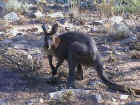 The first euro we saw (not seen the European ones yet!) |
|
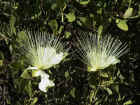 Native orange tree in flower |
|
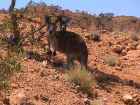 More euros! |
|
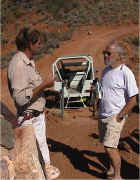 Our driver and guide Evan (= Euro Dundee) talking to Ray |
|
 Yellow footed rock wallaby |
|
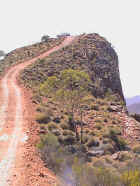 Sillers Lookout - culmination |
|
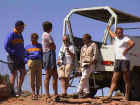 The Ridgetop Tour party on Sillers Lookout listening to Evan, second from right |
|
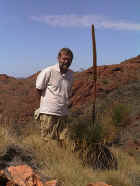 Flemming next to a grass tree. |